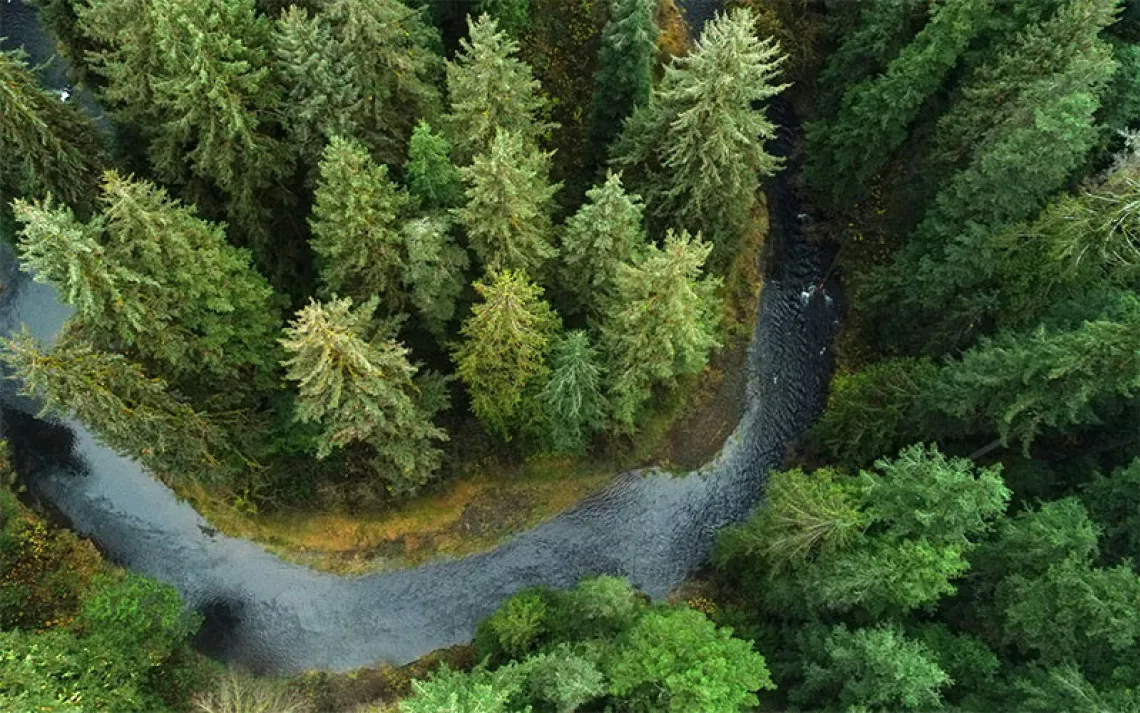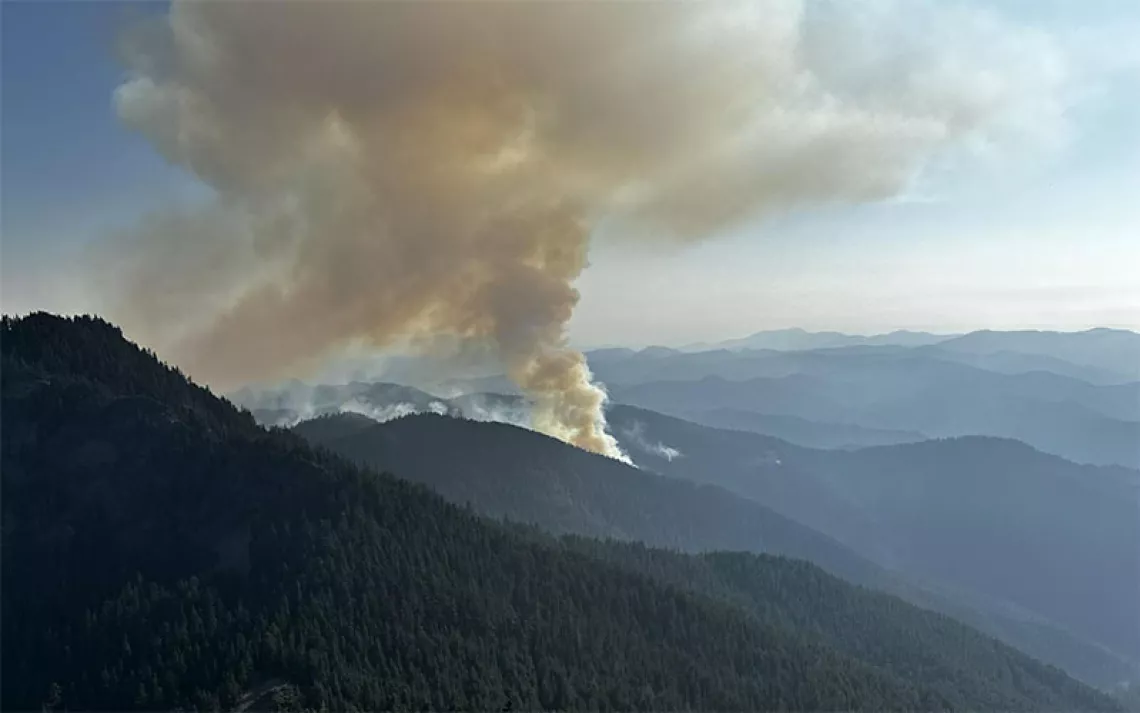How the Inflation Reduction Act Helps Forests Help Us
The landmark climate law is also good news for trees

Photo by iStock/ tigerstrawberry
The Inflation Reduction Act has been widely lauded for its climate-change-related provisions, which promise to reduce US greenhouse gas emissions by up to 40 percent by 2030. While the new law’s incentives for the domestic manufacturing of clean energy, rebates for electric vehicles, and a cap on methane leakage have grabbed headlines, the bill also contains a chunk of money aimed at protecting and promoting one of our most important climate-action tools: trees.
Though more modest than its energy and transportation elements, the Inflation Reduction Act’s forestry-related programs will mitigate climate change, create jobs, and make life better (and safer) for millions of people. The bill’s reach is broad: A rural town in the Sierra Nevada foothills, a private forestland owner in New England, and residents of a St. Louis neighborhood all stand to benefit from the law.
Here are some of the bill’s biggest beneficiaries when it comes to tree programs.
Private forestland owners
The Inflation Reduction Act appropriates $450 million for grant programs aimed at owners of private forestland. Funds are specifically allocated for underserved landowners in high-poverty areas and those with smaller parcels. The provision addresses an imbalance in the bipartisan Infrastructure and Jobs Act passed last year, which mostly funds programs aimed at public lands.
Private forestlands are essential for achieving our climate and wildfire mitigation goals, says Elizabeth Greener, communications director for the American Forest Foundation. About 39 percent—some 290 million acres—of the country’s forests are privately held. While some of these are “working lands” managed specifically for timber harvests, a good portion are rural properties that happen to have trees on them.
Rural property owners are usually not trying to make money off their trees, says Greener, but many would like to enhance wildlife habitat, reduce wildfire risk, and/or improve the general health of their forest. This work is expensive, but grant programs can help cover the costs.
Most of the federal programs aimed at helping private forest owners manage their land fall under the Farm Bill. But only about one in three who apply for popular grant programs are accepted, Greener says. “There’s a lot of demand but not enough funding.”
The IRA bolsters these programs and also helps smaller forest owners access other funding options, like carbon markets, that are designed to boost forests’ carbon-storing potential. Once a landowner implements a practice—replanting a burned area, for example, or switching to a longer harvesting rotation—they can sell carbon credits to companies.
An example of the kinds of programs the funding will help support is the Family Forest Carbon Program, which the American Forest Foundation and the Nature Conservancy developed to reach a wider pool of landowners, including those with smaller parcels and fewer financial resources.
“We provide funding to landowners upfront,” Greener says. “Once they implement the practice, we sell the carbon credits to companies. It’s backwards to how a traditional carbon program works.” Landowners with as few as 30 acres can enroll.
Greener says the ultimate goal is meaningful climate mitigation. “The US won’t be able to accomplish its forest-related climate goals unless they figure out how small landowners can implement climate-smart solutions on their properties,” she says.
Trees in the cities
One of the biggest line items in the IRA’s forestry budget goes to urban forests: Some $1.5 billion is appropriated for the Urban and Community Forest Assistance program, which provides technical and financial help to local communities so they can plant and maintain urban trees, educate citizens about tree care, and train tree workers.
“Access to urban green space and trees do a lot of wonderful things for people,” says Rachel Holmes, urban forestry strategist for the Nature Conservancy and co-chair for the Sustainable Urban Forest Coalition. Study after study validates the benefits of urban tree cover: Views of nature outside the classroom can positively influence kids’ test scores and behavior; greener neighborhoods experience less crime.
But those sprawling maples and elms do more than soothe the soul. So-called green infrastructure can also mitigate climate change by cooling city streets and slowing the flow of stormwater.
Yet urban trees have it tough, Holmes says. “I call them frontline forests predominantly because the impacts of climate change are going to hit people and trees in cities worst and first.” Temperatures are rising faster in cities, and drought stress can make trees more vulnerable to insect pests and diseases. Extreme storms and flooding also take a toll on city trees.
The IRA funding will help focus attention on an oft-neglected but critical aspect of urban forestry: maintenance. Mature trees (those between 30 and 60 years old) are the workhorses of the urban forests. But those trees must be cared for—or if they’re unhealthy, dead, or dying, they need to be removed to make way for a new tree.
The funding will help programs like Treesilience, which emphasizes the maintenance of trees on private properties. The Nature Conservancy developed the program in partnership with the Forest Service, and it has been piloted in Chicago, St. Louis, and Orlando.
The IRA funding will also help address the inequities of urban tree cover. Trees are not evenly distributed across city landscapes. Poor neighborhoods and communities of color are often starved of green space. A 2021 analysis of urban tree cover showed that in 92 percent of American communities, low-income neighborhoods have less tree cover than wealthier neighborhoods.
The Inflation Reduction Act seeks to address this inequity by leveling the playing field among the organizations that compete for funding. In July, Forest Service chief Randy Moore announced that the agency will waive the traditional grant match requirement for Native American tribes, and that the match may be waived or reduced for other partners.
“That’s huge,” Holmes says. “Right now, if someone’s applying for $100,000, they must either front the money ahead of time or match it dollar for dollar. For smaller nonprofits, those funds are almost inaccessible.”
Although the funding windfall is a huge opportunity, there are going to be growing pains. “We will need to see capacity increases in the field and at the Forest Service level,” Holmes says. “We in the urban forestry community are going to have to do a lot of work to make sure the money reaches the communities and entities that are best positioned to use it.”
A likely boon for wildfire mitigation
The Inflation Reduction Act bolsters several federal conservation and restoration programs. The Forest Legacy Program, which states and land trusts use to acquire forestland so it can’t be converted to farms or subdivisions, is getting a $700 million infusion. A new program to protect mature and old-growth forests will receive $50 million, at a time when conservation groups are calling for strengthened protections for older trees for their role in storing carbon and preserving biodiversity. Another $100 million will go to environmental reviews. But the biggest portion of funding is reserved for forest restoration and wildfire risk mitigation, particularly in the wildland-urban interface, where human communities abut forests or other natural vegetation.
Development in the wildland-urban interface has spiked in recent years, along with the risk of large, destructive wildfires. “Treating” the fuel in this zone—chipping, burning, thinning, and pruning trees, shrubs, and other vegetation—is a widely used strategy for reducing this risk, but the work is labor-intensive and time-consuming.
The Inflation Reduction Act allocates $1.8 billion to “hazardous fuels reduction” projects on national forests within the wildland-urban interface. This windfall comes on top of funding through the bipartisan Infrastructure and Jobs Act, which directs the Forest Service to treat at least 10 million acres in the wildland-urban interface or “a public drinking water source area” by 2027. Most of this work will likely take place in the fire-prone West.
“As someone who’s been working on forest issues for over 20 years, it’s abundantly clear that the agency has been starved for resources and did need money to do mission-critical work, including hiring and training people,” says Susan Jane Brown, staff attorney with the Western Environmental Law Center.
The Forest Service has a capacity problem: The agency desperately needs personnel, from entry-level wildland firefighters and forestry technicians to planners who work on environmental reviews. Without enough people on the ground, the money can’t be put to work in the right places.
Brown also expressed a growing concern with how the Forest Service is handling the infusion of cash from last year’s infrastructure bill. In January, the Forest Service announced 10 landscape-scale projects in eight western states where the agency will be working with partners to reduce the wildfire risk through thinning, prescribed burning, and other strategies.
“I think landscape-level restoration is needed and necessary, but Congress clearly told the Forest Service to first focus on the [wildland-urban interface] and hazardous fuels reduction there, and it’s not clear that that’s what is happening,” says Brown.
Brown worries that, based on what she is seeing with the infrastructure money, the funding from the Inflation Reduction Act has the potential to be misspent. At the very least, it will be difficult for both the public and the agency to track the deluge of cash.
By including so many forestry provisions in the Inflation Reduction Act, Congress has acknowledged the huge role forests play in combating and adapting to climate change, and the threats forests face from wildfire, drought stress, and temperature extremes. Money may not grow on trees, but when put into the right hands, money can help forests thrive, and we’ll all be better off because of it.
 The Magazine of The Sierra Club
The Magazine of The Sierra Club



